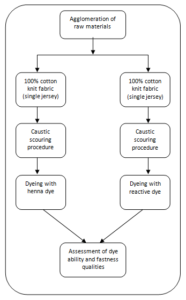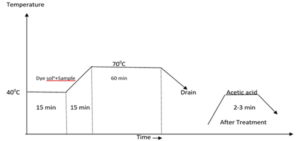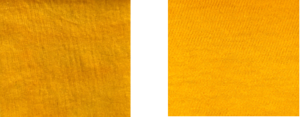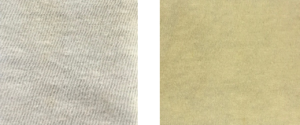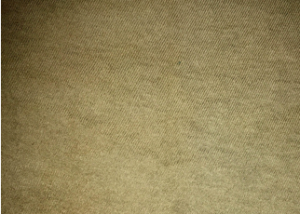Engineering and Applied Science Letter
ISSN: 2617-9709 (Online) 2617-9695 (Print)
DOI: 10.30538/psrp-easl2021.0067
Dye ability of henna dye towards cotton fabrics in comparison with reactive dye by following reactive dyeing procedure
Pranay Dutta\(^1\), Md. Razaya Rabbi, Mohammad Abu Sufian, Shahnaz Mahjebin
Department of Textile Technology, Chittagong Technical College, Chattogram, Bangladesh.;(P.D)
Department of Merchandising Opex and Sinha Textile Group, Narayangonj, Bangladesh.;(M.R.R)
Department of Wet Processing, Textile Engineering College Zorargonj, Chattogram, Bangladesh.; (M.A.S)
Department of Industrial Engineering, Regency Garments Ltd., Chattogram, Bangladesh.; (S.M)
Abstract
Keywords:
1. Introduction
The country such as Bangladesh has very much potential in the textile sector. In the garments sectors of our country, mainly woven and knit fabrics are used. Nowadays, Bangladesh has attained the top most leading position in the garments business. To help the garment industry, a large number of the other textile sectors have been developed and there will be more in the near future [1].
However, the textile industry includes many sections with operating operations, one of which is the dyeing industry for coloring fabrics. The textile dyeing industry's contribution as a whole is essential to make fabrics with different shades. For this reason, to produce different shades on fabrics, textile dyes play a significant role. Moreover, textile dyes are a potentially important component of the industry as a whole. As Bangladesh is abundant in natural resources, the production of dyes in Bangladesh is relatively simple and easier. The textile dyes industry is booming in Bangladesh because of the textile industry's growth in the emerging economies [2]. Additionally, it is estimated that the Textile Dyes Market, which was accounted for USD 7.34 billion in 2017, will increase to USD 9.82 billion by 2022 [3]. That's why fabric dyeing processing has become the talked of topics today in our country.
In textile manufacturing, dyes are derived from two primary sources: natural dyes and synthetic dyes. Natural dyes can be characterized as organic materials that have the potential to add color to any substance for that they may have had an affinity. Natural dyes are environmentally friendly and very compliant with the environment, as they can be derived either from plants, animals, or minerals. They have beauty, depth of color, and less bright than synthetic dyes, but these natural color components were sustainable and biodegradable [4,5,6,7].
Compared to natural dyes, synthetic dyes have become commonly used due to cheaper costs [7,8] and a wide variety of vibrant colors with dramatically enhanced color fastness properties [6,9]. For example, reactive dyes have a chromophore group that is responsible for reacting with the substrate. These dyes have good color fastness properties due to the covalent bond established while dyeing [9,10]. The use of synthetic dyes became more appropriate in the food, cosmetic, and textile industry. Although most of the synthetic dyes were prepared from chemical compounds recently, those were not always welcoming for the human. However, all the natural dyes were suitable for humans, and these dyes did not harm the skin [11,12,13]. Furthermore, they have reduced toxicity and adverse reactions than that of synthetic dyes. Needless to say, many synthetic dyes have been forbidden since they induce allergy or carcinogenicity like symptoms.
Due to increased consciousness of the therapeutic properties of colors, global demand for natural dyes is of significant concern today. Though natural dyes applied in food are evaluated for protection, the details are not available for other natural dyes used in craft dyeing and possibly for boarder use. There is a reason to suppose that natural consumables are better than manufactured goods because they naturally have been made. If they are more commonly and commercially used, the safety of natural dyes must be demonstrated [5]. With respect to environmental considerations, the use of renewable non toxic and gentle natural colors needs to be reconsidered. Environment friendly natural dyes are a well-known phenomenon which produces innovative ideas. This is because it may be a viable choice for our dyeing requirements.
Highlighting certain of such problems, the purpose of this study was to determine the dye ability of henna dye towards cotton fabrics in contrast with the reactive dye using reactive dyeing technique.
2. Design of experiment
The test design is shown in the following Figure 1.Figure 1. Flowchart illustration of experimental concept
3. Method and materials
3.1. Materials
In this paper's experiment, 100% single jersey cotton knit fabric was used. The yarn count of the fabric was 28s meant that the single-ply yarn of 28 Ne had been used to make the fabric. The GSM (Gram per Square Meter) of the fabric was 160.3.2. Chemicals
The Four H Dyeing & Printing Ltd supplied caustic scoured as well as bleached cotton knit fabric for the dyeing purposes. Four H Dyeing & Printing Ltd. was responsible for the supply of chemical auxiliaries, including sequestering agent, wetting agent, detergent, leveling agent, glauber salt, sodium carbonate, and acetic acid.3.3. Additional materials and equipments
The instruments and ingredients for the research are as follows: electric balance, open dye bath, water, henna leaves, oven dryer, pot, reactive dye, rota wash fastness tester and crock meter.3.4. Henna leaves preparation for test
Firstly, the leaves of Henna were taken from the plant. The leaves were cleaned off so as to eliminate dirt and adjunct material from the leaves. Then, with a view to removing the leaves' water content, the leaves were dried for several days under room temperature. For removal of the dye from the leaves, the dried leaves were pulverized with a grinding machine where the dried leaves were turned into powder form. After that, the powder was screened with a strainer to erase some stalk that is not well-pulverized.3.5. Dye extraction process of henna dyes
A half kilogram of henna powder, along with the pH level of 9, was weighed in soda ash solution and kept for 24 hours under room temperature. Indeed, the solution of henna was reddish-orange color. Until the color was separated from the powder to the aqueous media, the mixture was impregnated with soda ash solutions. Reddish orange color has been formed when the liquid is alkaline. In the alkaline reddish-orange henna solution, acetic acid has been added to make pH neutral. The solution was mixed into a funnel with 5 ml of chloroform since it was natural dyes compound. After that, the solution was desiccated with glauber salt; as a result, the orange-yellow solution was produced. Until chloroform was volatilized, the solution was kept out of the sun. In the end, the mixture was then stored separately for storage. Henna leaves are shown in Figure 2 and henna powder is shown in Figure 3.Figure 2. medium
Figure 3. Henna powder (dyes)
3.6. Operation for dyeing
The following techniques have been utilized in the study are explicated in the below.Process: For 5% and 10% shade, 5% and 10% of dyestuffs, i.e., henna dye and reactive dye, has been used. Moreover, 10 gram per liter of glauber salt, 5 gram per liter of Sodium Carbonate, 2 gram per liter of Leveling Agent, 2 gram per liter of Sequestering Agent, 1 gram per liter of Wetting Agent, temperature \(70^{o}C\), time 60 minutes, 20 gm of fabric weight, and 1:30 of Materials to Liquor ratio were used. Firstly, samples and stock solutions were prepared according to the recipe. The required amounts were then taken from the stock solution by burette and measuring cylinder into an open bath. The bath was placed over an oven and stirred continuously. A thermometer was used to measure and control the temperature of the dye bath. When the temperature reached \(40^{o}C\), the soaked and squeezed sample was given to the bath with continuous stirring. After that, the temperature rose to \(70^{o}C\) within 15 minutes and maintained the temperature for 60 minutes. Then the fabric sample was taken out of the bath and rinsed with cold water. To perform after treatment, the washed sample was treated with 1 gram per liter of acetic acid at \(40^{o}C\) for 2-3 min to remove unfixed dye molecules from the fabric surface. In an oven dryer, samples are dried by hot air.
3.7. Analysis of colour fastness to rubbing
Assessment of Color Fastness to Rubbing ISO 105-X12: 1993 method was used to conduct the fabric test. Using crock meter, \(20cm\times5cm\) of sample size, \(5cm\times 5cm\) of bleached fabric, and given rotation of 10 cycles for 10 seconds to carry out the test.3.8. Analysis of colour fastness to washing
ISO 105-C06 B2S procedure was used to execute the fabric test. 1 gram per liter of \(BNaO_3·4H_{2}O\) 4 gram per liter of ECE phosphate detergent were used. In addition, \(10cm \times 4cm\) of sample size, \(10cm \times 4cm\) of multi-fiber size, and 25 numbers of steel balls were used at 50°C for 30 minutes to perform the test.3.9. I. Analysis of Colour Fastness to Perspiration
ISO 105-E04:2013 method was used to operate the fabric test. For the acidic solution, 5 gram per liter of sodium chloride, 2.2 gram per liter of sodium dihydrogen orthophosphate dihydrate, and 0.5 gram per liter of L-Histidine monohydrochloride monohydrate were used. Besides, \(10cm \times 4cm\) of sample size and \(10cm \times 4cm\) of multi-fiber size were used at \(38^{o}C\) for 4 hours 5 minutes to carry out the test. The solution's pH value was 5.5 that were maintained entirely in the perspiration (acid) test.Furthermore, for the alkaline solution, 5 gram per liter of sodium chloride, 2.5 gram per liter of disodium hydrogen phosphate dehydrate, and 0.5 gram per liter of L-Histidine monohydrochloride monohydrate were used. Moreover, \(10cm \times 4cm\) of sample size and \(10cm \times 4cm\) of multi-fiber size were used at \(38^{o}C\) for 4 hours 5 minutes to operate the test. The solution's pH value was 8.0 that were maintained entirely in the perspiration (alkaline) test. The graphical representation of dyeing curve is given in Figure 4.
Figure 4. Graphical representation of dyeing curve
4. Result and discussion
4.1. Colour fastness to rubbing
From Table 1, it can say that the result of rubbing fastness to dry values of the cotton fabric dyed with henna dye was as same as the cotton fabric dyed with reactive dye, which was shown excellent results. Besides, it can be said that the result of rubbing fastness to wet values of the cotton fabric dyed with henna dye was shown very good results for 5% and 10% shade. Conversely, the result of rubbing fastness to wet values of the cotton fabric dyed with reactive dye was shown good and fair results for 5% and 10% shade, respectively. Hence, from the above discussion, we can say that in comparison with the cotton fabric dyed with reactive dye specimens, henna dye treated cotton fabrics deliver greater values for 5% and 10% shade.
Table 1. Effect of color fastness to rubbing.
| Dye Name | % of Shade | Type | Result |
|---|---|---|---|
| Henna | 5.0% | Dry | 5 |
| Wet | 4/5 | ||
| 10.0% | Dry | 5 | |
| Wet | 4/5 | ||
| Reactive | 0.5% | Dry | 5 |
| Wet | 4 | ||
| 10.0% | Dry | 5 | |
| Wet | 3 |
4.2. Colour fastness to washing
From Table 2, Color fastness to wash demonstrates the effects in terms of color staining. These findings indicate that the wash materials vary in the cotton fabric dyed with reactive dye specimens and the cotton fabric dyed with henna dye specimens depending on the nature of the color's fastness. Yet, henna dye treated cotton fabrics showed more affinity towards protein fiber than cellulosic fiber, understood from the multi-fiber grading in wash fastness.
Table 2. Effect of color fastness to washing.
| % of Dye | Color Staining | Grade |
|---|---|---|
| 5% Reactive | Cotton | 4/5 |
| Nylon | 5 | |
| Polyester | 5 | |
| Acrylic | 5 | |
| Wool | 3 | |
| 55 % Henna | Cotton | 4/5 |
| Nylon | 5 | |
| Polyester | 5 | |
| Acrylic | 5 | |
| Wool | 3/4 |
4.3. Colour fastness to perspiration
From Table 3, it has been seen that caustic soda-treated fabric with reactive dye has been shown lower values than that of henna dye since the henna dye is more responsive to cotton fabric binding.
Table 3. Effect of color fastness to perspiration.
| Dye Name | % of Shade | Type | Result |
|---|---|---|---|
| Henna | 5.0% | Dry | 5 |
| Wet | 4/5 | ||
| 10.0% | Dry | 5 | |
| Wet | 4/5 | ||
| Reactive | 0.5% | Dry | 5 |
| Wet | 4 | ||
| 10.0% | Dry | 5 | |
| Wet | 3 |
4.4. Swatches
Figure 5. 5% Reactive 10% Reactive
Figure 6. 5% Henna 10% Henna
Figure 7. 50% Henna
5. Conclusion
From the above discussion, it is understood that henna dye shows poor to moderate dye ability towards cotton fabrics in comparison with reactive dye if the reactive dyeing procedure is followed for henna dyeing. As opposed to the reactive dye, henna dye showed satisfactory fastness properties. In case of henna dye for 50% shade, it gives an excellent color tone with good level dyeing. This study's findings also show that natural henna derived dyes are not intended for decorating finger-nails, dyeing hair, or cosmetic products, but can also be used to impart textile colors, including cotton and protein fiber, to a certain degree. The outcome of this experiment would also introduce a rising need for organic garments to environmentally conscious customers. The mordant uses can be reduced by using natural dye, which ultimately results in showing eco-friendly dyeing. This study was practice-based, and the results are useful for the workers in the textile industries, who have been accountable for the color-fastness control and dyeing of textile materials with natural dyes.Author Contributions
All authors contributed equally to the writing of this paper. All authors read and approved the final manuscript.Conflicts of Interest
The authors declare no conflict of interest.References
- Rabbi, M. A., Hasan, M. M., & Akhter, A. (2016). Heavy metals content in inlet water, treated and untreated waste water of garments industries at Gazipur, Bangladesh. Environmental Science: An Indian Journal, 12(4), 133-136. [Google Scholor]
- Fibre2fashion.com, 'Booming textile dyes industry in emerging economies', 2014. [Online]. Available: https://www.fibre2fashion.com/industry-article/7422/booming-textile-dyes-industry-in-emerging-economies. [Accessed: 12- Jan- 2021]. [Google Scholor]
- Prnewswire.com, 'Textile Dyes Market Worth 9.82 Billion USD by 2022', 2018. [Online]. Available: https://www.prnewswire.com/news-releases/textile-dyes-market-worth-982-billion-usd-by-2022-678731413.html. [Accessed: 16- Jan- 2021]. [Google Scholor]
- Udeani, N. A. (2015). Potential of Henna leaves as dye and its fastness properties on fabric. International Journal of Chemical and Molecular Engineering, 9(12), 1459-1466. [Google Scholor]
- Alam, M. M., Rahman, M. L., & Haque, M. Z. (2007). Extraction of henna leaf dye and its dyeing effects on textile fibre. Bangladesh Journal of Scientific and Industrial Research, 42(2), 217-222. [Google Scholor]
- Shabbir, M., Rather, L. J., Bukhari, M. N., Ul-Islam, S., Shahid, M., Khan, M. A., & Mohammad, F. (2019). Light fastness and shade variability of tannin colorant dyed wool with the effect of mordanting methods. Journal of Natural Fibers, 16(1), 100-113. [Google Scholor]
- Adeel, S., Rehman, F. U., Rafi, S., Zia, K. M., & Zuber, M. (2019). Environmentally friendly plant-based natural dyes: Extraction methodology and applications. In Plant and Human Health, Volume 2 (pp. 383-415). Springer, Cham. [Google Scholor]
- Shahid-ul-Islam, Rather, L. J., Shabbir, M., Sheikh, J., Bukhari, M. N., Khan, M. A., & Mohammad, F. (2019). Exploiting the potential of polyphenolic biomordants in environmentally friendly coloration of wool with natural dye from Butea monosperma flower extract. Journal of Natural Fibers, 16(4), 512-523. [Google Scholor]
- Patil, S. P., Pandit, P., & Laddha, K. S. (2020). Eco-friendly Single Bath Dyeing and Ultraviolet Protective Finishing of Proteinous Fabric Using Loganin Derived Blue Dye. Journal of Natural Fibers, 17(12), 1748-1756.[Google Scholor]
- Velmurugan, P., Vedhanayakisri, K. A., Park, Y. J., Jin, J. S., & Oh, B. T. (2019). Use of Aronia melanocarpa fruit dye combined with silver nanoparticles to dye fabrics and leather and assessment of its antibacterial potential against skin bacteria. Fibers and Polymers, 20(2), 302-311. [Google Scholor]
- Rather, L. J., Shabbir, M., Li, Q., & Mohammad, F. (2019). Coloration, UV protective, and antioxidant finishing of wool fabric via natural dye extracts: cleaner production of bioactive textiles. Environmental Progress & Sustainable Energy, 38(5), 13187. [Google Scholor]
- Rather, L. J., Khan, M. A., & Mohammad, F. (2019). Biomordanting Potential of Acacia nilotica (Babul) in Conjunction with Kerria lacca and Rheum emodi Natural Dyes. Journal of Natural Fibers, 16(2), 275-286. [Google Scholor]
- Jiang, H., Hu, X., Meena, B. I., Khan, A., Hussain, M. T., Yao, J., & Wang, J. (2019). Extraction of natural dyes from the stem of Caulis spatholobi and their application on wool. Textile Research Journal, 89(23-24), 5209-5217. [Google Scholor]

